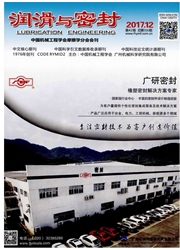

 中文摘要:
中文摘要:
采用Nd:YAG激光器在A12O3/TiC陶瓷刀具材料表面加工出不同密度的微孔,并涂覆填装MoS,固体润滑剂,在UMT-2摩擦磨损试验机上进行往复摩擦试验,研究其在不同载荷和速度下的摩擦磨损性能,通过自光干涉仪、光学显微镜和扫描电镜观察激光织构化后表面特征和磨损后表面形貌。结果表明:激光织构化后,陶瓷材料表面发生了氧化;在相同的实验条件下,与光滑表面相比较,填装MoS2固体润滑剂的微孔表面能够有效地降低摩擦因数,减小磨损率。这主要是由于填装在微孔中的润滑剂在摩擦作用下涂覆到基体表面,形成润滑膜,起到减摩降磨作用,同时激光加工后微孔周围凸起及氧化后形成的摩擦特性优良的TiO2也能起到良好的减摩降磨效果。通过对磨损形貌分析,光滑表面磨损较为严重,有大量的犁沟产生,主要的磨损形式为磨粒磨损及脆性断裂;微孔表面磨损较为轻微,其主要磨损发生在微孔周围。
 英文摘要:
英文摘要:
Dimples with diameter of 50 μm on A12O3/TiC ceramic surface were produced by Nd:YAG laser, and were filled with MoS2 solid lubricants. The tribological properties of the dimpled surface against a 440C stainless steel ball were investigated by sliding tests. The morphology of the dimple and micrograph of worn surface were observed using an optical microscope, white light interferometer, and scanning electron microscope(SEM). The results show that the dimpled surface filled with MoS2 solid lubricants exhibits lower friction coefficients and excellent anti-wear properties compared with non- dimpled surface, because the MoS2 film in the space between the dimples is formed by mechanical engagement of particles in the rough surface and solid lubricants in dimples. The friction coefficient and wear rate are reduced by supply of solid lubricants from the dimples to the surface, bulges and TiO2 formed after laser texturing. The main wear mechanism of non- dimpled surface is brittle fracture and a few ploughs, and SEM photographs indicate that dimpled surface can decrease ploughs and the main wear occurrs around the dimples.
 同期刊论文项目
同期刊论文项目
 同项目期刊论文
同项目期刊论文
 Performance of carbide tools with textured rake-face filled with solid lubricants in dry cutting pro
Performance of carbide tools with textured rake-face filled with solid lubricants in dry cutting pro Preparation of tungsten disulfide (WS2) soft-coated nano-textured self-lubricating tool and its cutt
Preparation of tungsten disulfide (WS2) soft-coated nano-textured self-lubricating tool and its cutt Friction and wear behaviors of the carbide tools embedded with solid lubricants in sliding wear test
Friction and wear behaviors of the carbide tools embedded with solid lubricants in sliding wear test Influence of negative bias voltage on the mechanical and tribological properties of MoS2/Zr composit
Influence of negative bias voltage on the mechanical and tribological properties of MoS2/Zr composit Unlubricated friction and wear behaviors of Al2O3/TiC ceramic cutting tool materials from high tempe
Unlubricated friction and wear behaviors of Al2O3/TiC ceramic cutting tool materials from high tempe Effect of depositing parameters on microstructures and properties of multi arc ion plating ZrTiN fil
Effect of depositing parameters on microstructures and properties of multi arc ion plating ZrTiN fil 期刊信息
期刊信息
